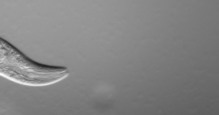Caenorhabditis elegans
Caenorhabditis elegans (C. elegans) is a free-living, transparent nematode (roundworm), about 1 mm in length, that lives in temperate soil environments. It is a model organism widely used in molecular and developmental biology, particularly in studies related to genetics, neuroscience, aging, and disease.
Biology and Life Cycle[edit | edit source]
C. elegans has a simple body plan, including a digestive system with a mouth, intestine, and anus, as well as a simple nervous system with around 302 neurons in the hermaphrodite and slightly more in the male. The organism is primarily hermaphroditic (producing both sperm and eggs), with males occurring rarely and arising by non-disjunction of the X chromosome. The life cycle of C. elegans can be completed in about 3 days at 25°C, passing through four larval stages (L1–L4) before reaching adulthood.
Genetics[edit | edit source]
The genome of C. elegans was fully sequenced in 1998, making it the first multicellular organism to have its genome completely sequenced. The genome consists of approximately 100 million base pairs and contains about 20,000 protein-coding genes. Research on C. elegans has contributed significantly to the understanding of gene function and regulation, apoptosis (programmed cell death), and has been instrumental in the discovery of RNA interference (RNAi).
Research and Applications[edit | edit source]
C. elegans is extensively used in scientific research due to its simplicity, transparency, and ease of genetics. Its short lifespan and well-defined developmental stages make it an excellent model for studying aging and developmental processes. Additionally, the conservation of many biological pathways between C. elegans and humans allows for the study of human diseases, including neurodegenerative diseases and cancer.
Notable Discoveries[edit | edit source]
Several groundbreaking discoveries in biology have been made through studies on C. elegans, including the mechanisms of programmed cell death (apoptosis), the process of RNA interference (RNAi), and insights into neural development and function. These discoveries have had profound implications for biology and medicine, leading to Nobel Prizes in Physiology or Medicine for research conducted on C. elegans in 2002 and 2006.
Laboratory Use[edit | edit source]
In the laboratory, C. elegans is easy to maintain, requiring only a simple agar plate with a source of bacteria (usually Escherichia coli) for food. Its small size, ease of storage, and the ability to freeze and revive individuals make it an ideal model organism for genetic studies. Mutant strains and transgenic lines are widely available, facilitating research in various fields.
Conclusion[edit | edit source]
C. elegans continues to be a vital model organism in biological research, offering insights into fundamental biological processes and human diseases. Its simplicity, coupled with the depth of knowledge accumulated through decades of research, ensures that it will remain at the forefront of scientific discovery.
Search WikiMD
Ad.Tired of being Overweight? Try W8MD's physician weight loss program.
Semaglutide (Ozempic / Wegovy and Tirzepatide (Mounjaro / Zepbound) available.
Advertise on WikiMD
|
WikiMD's Wellness Encyclopedia |
| Let Food Be Thy Medicine Medicine Thy Food - Hippocrates |
Translate this page: - East Asian
中文,
日本,
한국어,
South Asian
हिन्दी,
தமிழ்,
తెలుగు,
Urdu,
ಕನ್ನಡ,
Southeast Asian
Indonesian,
Vietnamese,
Thai,
မြန်မာဘာသာ,
বাংলা
European
español,
Deutsch,
français,
Greek,
português do Brasil,
polski,
română,
русский,
Nederlands,
norsk,
svenska,
suomi,
Italian
Middle Eastern & African
عربى,
Turkish,
Persian,
Hebrew,
Afrikaans,
isiZulu,
Kiswahili,
Other
Bulgarian,
Hungarian,
Czech,
Swedish,
മലയാളം,
मराठी,
ਪੰਜਾਬੀ,
ગુજરાતી,
Portuguese,
Ukrainian
Medical Disclaimer: WikiMD is not a substitute for professional medical advice. The information on WikiMD is provided as an information resource only, may be incorrect, outdated or misleading, and is not to be used or relied on for any diagnostic or treatment purposes. Please consult your health care provider before making any healthcare decisions or for guidance about a specific medical condition. WikiMD expressly disclaims responsibility, and shall have no liability, for any damages, loss, injury, or liability whatsoever suffered as a result of your reliance on the information contained in this site. By visiting this site you agree to the foregoing terms and conditions, which may from time to time be changed or supplemented by WikiMD. If you do not agree to the foregoing terms and conditions, you should not enter or use this site. See full disclaimer.
Credits:Most images are courtesy of Wikimedia commons, and templates, categories Wikipedia, licensed under CC BY SA or similar.
Contributors: Prab R. Tumpati, MD





